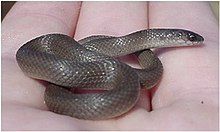Earth snake
| Virginia | |
|---|---|
 |
|
| Virginia striatula, rough earth snake | |
| Scientific classification | |
| Kingdom: | Animalia |
| Phylum: | Chordata |
| Subphylum: | Vertebrata |
| Class: | Reptilia |
| Order: | Squamata |
| Suborder: | Serpentes |
| Family: | Colubridae |
| Subfamily: | Natricinae |
| Genus: |
Virginia Baird & Girard, 1853 |
| Synonyms | |
|
Amphiardis, Calamaria, Celuta, Coluber, Conocephalus, Falconeria, Haldea, Natrix, Potamophis |
|
Amphiardis, Calamaria, Celuta, Coluber, Conocephalus, Falconeria, Haldea, Natrix, Potamophis
Virginia is a genus of small, terrestrial, colubrid snakes, native to the United States. They are commonly referred to as earth snakes.
Ranges overlap; it is unknown if hybridization occurs.
Virginia species are small snakes, rarely exceeding 10 inches (25 cm) in total length. They are normally a uniform brown color, with a lighter colored underside. Differentiating species can be difficult, but V. valeriae has smooth scales, whereas V. striatula has keeled scales. V. pulchra has weakly keeled scales.
Virginia species are fossorial, spending the vast majority of their time buried in loose soil, under rotting logs, or in leaf litter.
They eat earthworms and soft bodied arthropods. They themselves are a food source for other species of snake, like the coral snake.
...
Wikipedia
